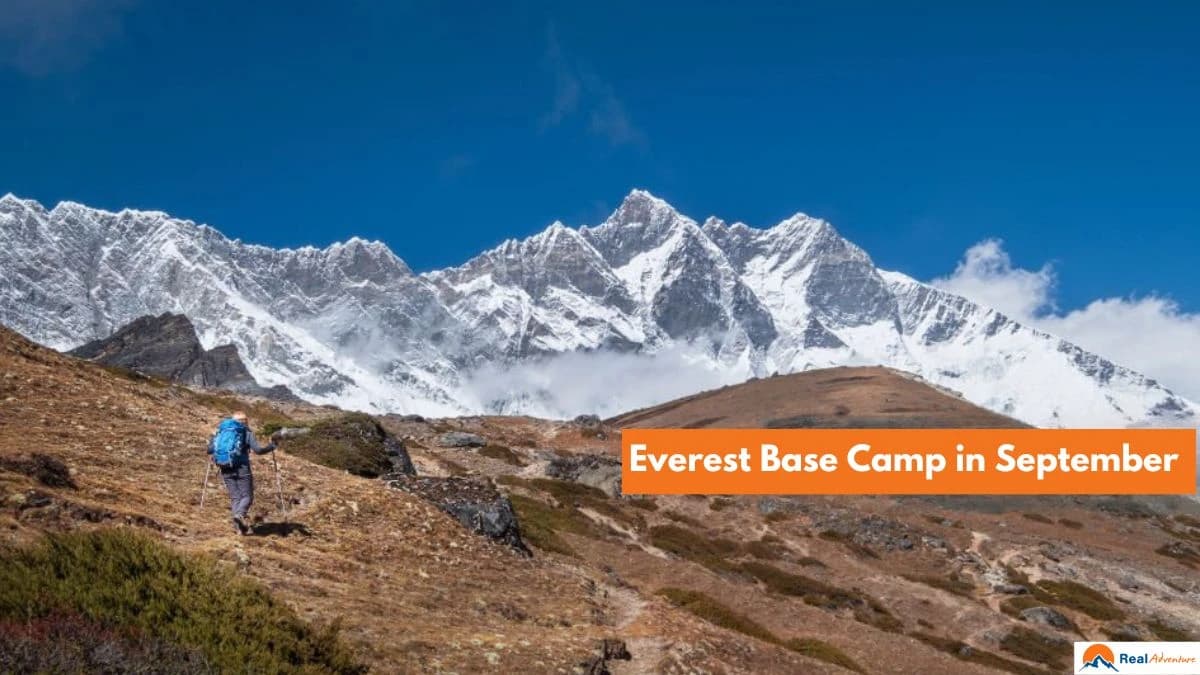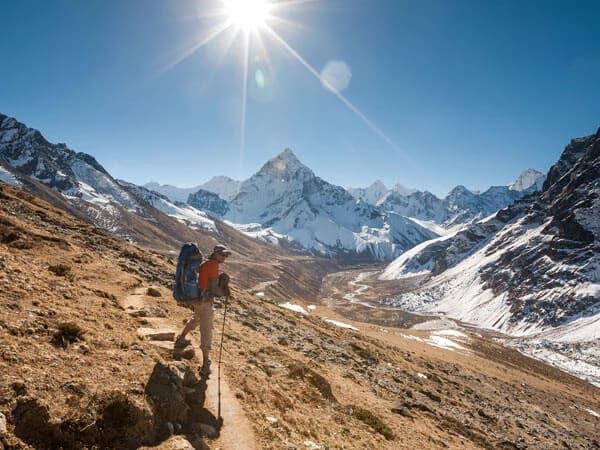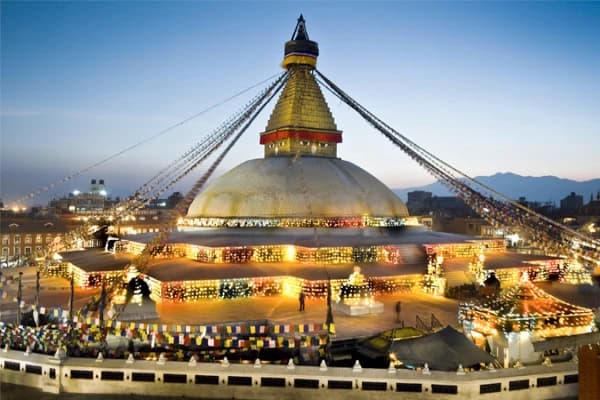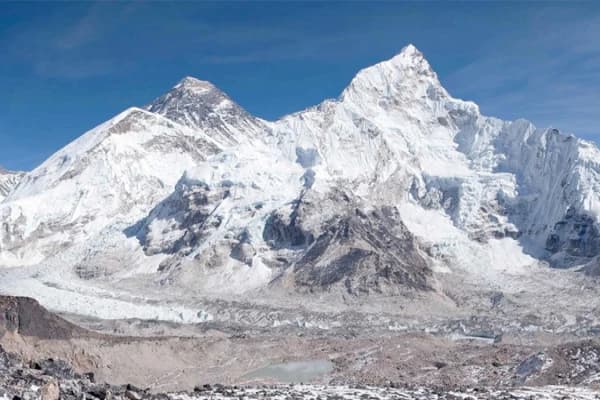Are you considering a trek to Everest Base Camp in September? Book your trek to EBC with Real Adventure. September is an excellent time to explore the trails in Nepal’s Khumbu region. Trekking in very cold or hot weather is challenging, so choosing an appropriate time is essential. September is the best time to trek, as it comes just after the monsoon season and before the busy autumn trekking period, and it is neither too cold nor too hot.
This month offers a pleasant time to trek with clear skies and stunning views of Mount Everest. There is less crowd, enabling you to enjoy the trail with fewer people and many opportunities to snap perfect photos without any disturbances. This month allows you to experience and join local Nepalese festivals like Indra Jatra and Teej. You can enjoy and learn about Nepali festivals, cross-cultural activities, and assimilation.
Explore more about Everest Base Camp Trek in September with our complete guide.
Should You Trek to Everest Base Camp in September?
The Everest Base Camp Trek in September is a wise decision. The clear skies and fresh views allow you to enjoy the beauty of the Himalayas. In September, the weather at Everest Base Camp offers daytime temperatures ranging from 10-20°C (50-68°F) in the lower altitudes, while nighttime temperatures can drop to around -10°C (14°F) at higher altitudes.
The pros of Everest Base Camp in September are:
Fewer Crowds: Compared to the peak trekking months of October and November, September sees fewer trekkers, allowing for a more serene experience. September suits those who love lesser and quieter trails without experiencing heavy human traffic. It makes the trek peaceful and enjoyable.
Beautiful Scenery and Clear Views: In September, after the monsoon, the forests become greener and denser, and pastures turn vibrant and lush. You'll see yaks grazing in these rich meadows. The rain also clears away dust, giving you clear views of peaks like Mount Everest and Ama Dablam, as well as forests, rivers, Sherpa villages, and monasteries. This lush scenery makes the Everest Base Camp trek more enjoyable and brightens your mood.
Weather: September marks the end of the monsoon season, so the weather begins to clear up, offering stunning views of the mountains. The climate is also quite pleasant, neither too hot nor too cold. This makes for a comfortable hike through remote settlements with rugged terrains and rocky landscapes.
Accommodation Availability: In September, accommodation availability along the Everest Base Camp (EBC) trek is generally reasonable. Many tea houses offer basic amenities, including clean beds, hot showers (often for an extra charge), and meals. While the accommodations are typically simple, they are comfortable and sufficient for trekkers, ensuring a pleasant stay during your journey.
Fresh Trails: The monsoon rains refresh the trails, making them more vibrant and scenic, though they may be muddy early in the month. The rain helps clear away dust, providing better visibility of the surrounding peaks and landscapes.
Cultural Interaction: During your trek, you'll have the opportunity to experience and join in local Nepalese festivals. In September, Nepal celebrates two notable festivals: Indra Jatra and Teej. You can enjoy and learn about Nepali festivals, cross-cultural activities, and assimilation.
How Hot is the Everest Base Camp Trek in September?
September is a mild month for trekking to Everest Base Camp. At lower elevations, daytime temperatures can range from 10–20°C (50–68°F), making trekking comfortable. Evenings and mornings can be colder, but with the right gear, you can stay warm and enjoy the adventure. The weather is generally pleasant, neither too hot nor too cold, making for a comfortable hike through remote settlements with rugged terrains and rocky landscapes.
Mornings and evenings at Everest Base Camp in September can be icy. Clouds can make it feel even chillier in the afternoon, even without strong wind.
How Cold Does it Get at Everest Base Camp in September?
The temperature at EBC in September can get much colder at night and at higher elevations, frequently falling to -10°C (14°F). Mornings and evenings can be chilly, so pack warm clothing for the nights during your EBC trek in September. It’s better to bring rainproof gear to stay comfortable and dry. The temperature is mild, with fewer clouds and clear visibility.
Itinerary for Everest Base Camp Trek in September
Day 01: Arrival in Kathmandu (1,400m/4,592ft) - Transfer to Hotel and Trek Preparation
Day 02: Fly from Kathmandu to Lukla (2,840m/9,316ft) and trek to Phakding (2,610m/8,561ft) - 35 minutes flight, 3 to 4 hours (8 km) trek
Day 03: Trek from Phakding to Namche Bazaar (3,440m/11,284ft) - 6 to 7 hours (10.5 km) trek
Day 04: First Acclimatization Day at Namche Bazaar (3,440m/11,284ft) - 3 to 4 hours trek
Day 05: Trek from Namche to Tengboche (3,860m/12,661ft) - 5 to 6 hours (10 km) trek
Day 06: Trek from Tengboche to Dingboche (4,410m/14,465ft) - 5 to 6 hours (11 km) trek
Day 07: Second Acclimatization Day at Dingboche (4,410m/14,465ft) - 4 to 5 hours trek
Day 08: Trek from Dingboche to Lobuche (4,910m/16,105ft) - 5 to 6 hours (8 km) trek
Day 09: Trek from Lobuche to Gorak Shep (5,140m/16,860ft) and visit Everest Base Camp (5,364m/17,594ft) - 7 to 8 hours (12 km) trek
Day 10: Trek to Kala Patthar (5550m/18,204ft) and descend to Pheriche (4,240m/13,908ft)—a 6 to 7-hour (12 km) trek.
Day 11: Trek from Pheriche to Namche (3,440m/11,284ft) - 7 to 8 hours (19 km) trek
Day 12: Trek from Namche to Lukla (2,840m/9,316ft) - 6 to 7 hours (18.5 km) trek
Day 13: Fly from Lukla to Kathmandu (1,400m/4,592ft) - 35 minutes flight
Day 14: Final Departure
How Do You Prepare for EBC in September?
Are you wondering what to pack for the Everest Base Camp Trek? Think layers. Daytime temperatures are usually mild, but it can get chilly quickly, especially at higher altitudes or as the sun sets. Be prepared for cold temperatures despite the pleasant weather, especially at night. With fewer trekkers, there might be fewer open teahouses, so plan your stops carefully.
Everest Base Camp (EBC) is a dream destination for many adventurers. As you plan to visit the base camp of Mount Everest's tallest peak, carefully consider your packing list. Bringing the right items is essential to avoid any issues during your journey.
What Should I Pack for the Everest Base Camp Trek in September?
Here are the must-have items for your Everest Base Camp Trek in September:
Hiking Boots: Essential for navigating the trek's varied terrain.
Trekking Poles: Useful for stability, especially on steep paths.
Down Jacket: Important for staying warm during chilly nights.
Sleeping Bag: Necessary for comfort in cold conditions.
Rain Gear: While rain is minimal, packing rain gear is wise.
Sunscreen: Protect your skin from the intense, high-altitude sun.
First Aid Kit: Include altitude sickness medication and basic first aid supplies.
Recommended Read:
Where To Buy Trekking Gear In Nepal?
Walking equipment is available in two of Nepal's most preferred and well-known places: Thamel in Kathmandu and Lakeside in Pokhara.
There are several rental stores in Kathmandu and Pokhara where you can rent anything from downcoats to sleeping bags without buying anything. This can be a more affordable choice if you go hiking infrequently.
The top choices for where to buy trekking gear in Nepal are Thamel and Lakeside, but our guide also covers other notable areas within these towns with specialized stores and brands that meet hikers' various demands.
Documentation, Permits & Travel Insurance
You'll need to acquire a trekking permit to explore these breathtaking landscapes, from verdant valleys to snow-covered peaks. This permit aids in environmental protection, ensures your safety on the trails, and supports the local communities you encounter.
To secure these permits, you'll need to provide several documents. The process is more complex than just requesting a permit; it involves following specific procedures. The required documents for obtaining Everest Base Camp permits include:
- A valid passport with at least six months of validity
- Two passport-sized photos
- A Nepal entry visa
- Cash to cover permit fees
- Travel insurance, which is highly recommended for rescue situations
Travelling in the Himalayas comes with its own set of risks. It’s essential to be prepared for unexpected dangers that may arise. Many insurance providers offer online travel insurance services, giving you various options. While minor health issues, accidents, and altitude sickness are always possible, especially at Nepal's high altitudes, adequate travel insurance can provide essential protection and peace of mind.
Do I Need Special September Everest Base Camp Trek Permits?
For the Everest Base Camp trek in September, you will need the following permits:
- TIMS (Trekkers' Information Management System) Card: This card is required for all trekkers. It helps manage trekking activities and ensures safety.
- Sagarmatha National Park Entry Permit: This permit is needed to enter Sagarmatha National Park, where Everest Base Camp is located.
- Khumbu Pasang Lhamu Rural Municipality Permit: This local permit is required for trekking in the Khumbu region and supports regional development projects.
Ensure you have these permits to enjoy a smooth and compliant trekking experience.
Wondering where to obtain the necessary permits for your Everest Base Camp trek? Here’s where you can get each of them:
- Sagarmatha National Park Permit: This permit is available at the Nepal Tourism Board Office in Kathmandu or the Park Entrance Gate in Monjo. It’s usually easier to obtain it directly at Monjo, where the park committee issues it.
- Khumbu Pasang Lhamu Rural Municipality Entrance Permit: If you're flying into Lukla, you can get this permit upon arrival. For those trekking from Jiri or Salleri, it’s available at the Sagarmatha National Park Counter in Monjo. Note that this permit cannot be issued in Kathmandu; it must be obtained in Lukla or Monjo, with a fee of NPR 2000.
Altitude Sickness
Altitude sickness is a significant concern during the September Everest Base Camp trek. As you ascend above 5000 meters, you become more susceptible to altitude-related issues such as AMS (Acute Mountain Sickness).
Before starting your trek, it's essential to understand altitude sickness and take steps to minimize its impact. Proper acclimatization and implementing safety measures are crucial. To reduce the risk of altitude sickness, ensure you maintain good nutrition, stay hydrated, get ample rest, and follow a gradual ascent and descent.
You may receive acetazolamide (Diamox) from a physician. This quickens your body's adaptation to the increased altitude. Altitude sickness is also treated with dexamethasone and nifedipine (Procardia). Altitude sickness may also be treated using oxygen or a pressure chamber that has been carefully made.
Accommodation and Meals on Everest Base Camp in September
Teahouses are the most common accommodation along the Everest Base Camp trek route. These basic lodges offer a bed, meals, and a communal area for socializing. Teahouses typically provide simple amenities, including beds with mattresses, pillows, and blankets. While some might have attached bathrooms, many offer shared facilities. In September, the trek is less crowded than during peak months, making it easier to find accommodation.
Most teahouses have limited electricity for lighting and device charging, often at an additional cost. Solar power is standard, but charging facilities may need to be more reliable. Wi-Fi is available in some teahouses, though it tends to be slow and comes with a fee. The availability of Wi-Fi decreases as you ascend higher.
Meals on the EBC trek are generally simple but hearty, and the shared dining space fosters a friendly, communal atmosphere among trekkers. Typical dishes include dal bhat (rice with lentil soup and vegetables), momos (dumplings), fried rice, pasta, and noodle soups. Dal bhat is particularly popular among trekkers for its high-energy content and the option for unlimited refills.
How Much Does Everest Base Camp Cost in September?
The cost of the Everest Base Camp trek in September can vary greatly from as little as $600 to thousands of dollars. This is the average starting price to budget for doing the trek in different styles.
For the Everest Base Camp Trek in September, Real Adventure offers a variety of packages with different experiences and costs. Here's a breakdown of the options:
14 Days Everest Base Camp Trek: $1,450
Short Everest Trek with Helicopter Return- 3 Days: $4500
Everest Base Camp Trek with Cho La Pass and Gokyo Ri - 19 Days: $1,599
Everest Base Camp Trek with Island Peak Climb - 19 Days: $2,699
The Everest View Luxury Lodge Trek - 8 Days: $3,890
Everest Three High Passes Trek - 22 Days: $2,900
5 Days Everest View Luxury Lodge Trek - Return by Helicopter: $4,250
Everest Base Camp Trek with Helicopter Return - 9 Days: $2,050
Each package is designed to cater to different preferences and levels of comfort, ranging from standard treks to more luxurious or challenging options.
Tips on Budgeting and Managing Expenses During the Trek
The main expenses you'll encounter during your trek are accommodation and food. In the mountains, staying in a guesthouse typically includes dining there for breakfast and dinner. The room cost is usually relatively low, with guest house owners earning most of their revenue from meals. Opting for local food is the most budget-friendly choice. Prices for chocolate bars, soft drinks, and alcohol can significantly increase your costs.
Many guesthouses offer basic amenities such as hot water and Wi-Fi for an extra fee, which can add up over time. To keep expenses manageable, it’s wise to budget for these extras and be mindful of any unexpected costs that may arise. Being prepared and understanding the local pricing structure can help you avoid financial surprises and maximize your trekking experience.
Summing Up
Trekking to Everest Base Camp in September offers a distinctive adventure with its lush, vibrant landscapes and favorable weather conditions. This time of year showcases the Himalayas in a refreshed state. The trails are less crowded than in peak seasons, allowing for a more serene and personal experience with the majestic surroundings. September is an excellent choice for a trek that combines natural splendor with fewer crowds and a refreshing environment.
FAQs
What is the weather like in base camp in September?
The weather at Everest Base Camp (EBC) in September is usually pleasant but can be erratic. While nightly lows can frequently reach -10°C (14°F) or lower at higher elevations, daytime highs are generally comfortable, ranging from 10°C to 15°C (50°F to 59°F).
Are the trails crowded in September?
September is less crowded than the peak trekking months of April and October. The trails are typically quieter, allowing for a more peaceful trekking experience.
Is the trek to Everest Base Camp in September safe?
September treks to Everest Base Camp are usually safe if you are well-prepared and adhere to safety precautions. It's critical to acclimate gradually and maintain hydration to prevent altitude sickness.
Do I need prior trekking experience for the Everest Base Camp trek in September?
No technical trail leads to Everest Base Camp, so you can finish the trek without any prior climbing experience. However, it can be challenging, and Acute Mountain Sickness (AMS) is also risky.






-(5).webp&w=1200&q=75&dpl=dpl_CtNAyRzUAwPdWKDCFxYk5p2VryPh)
